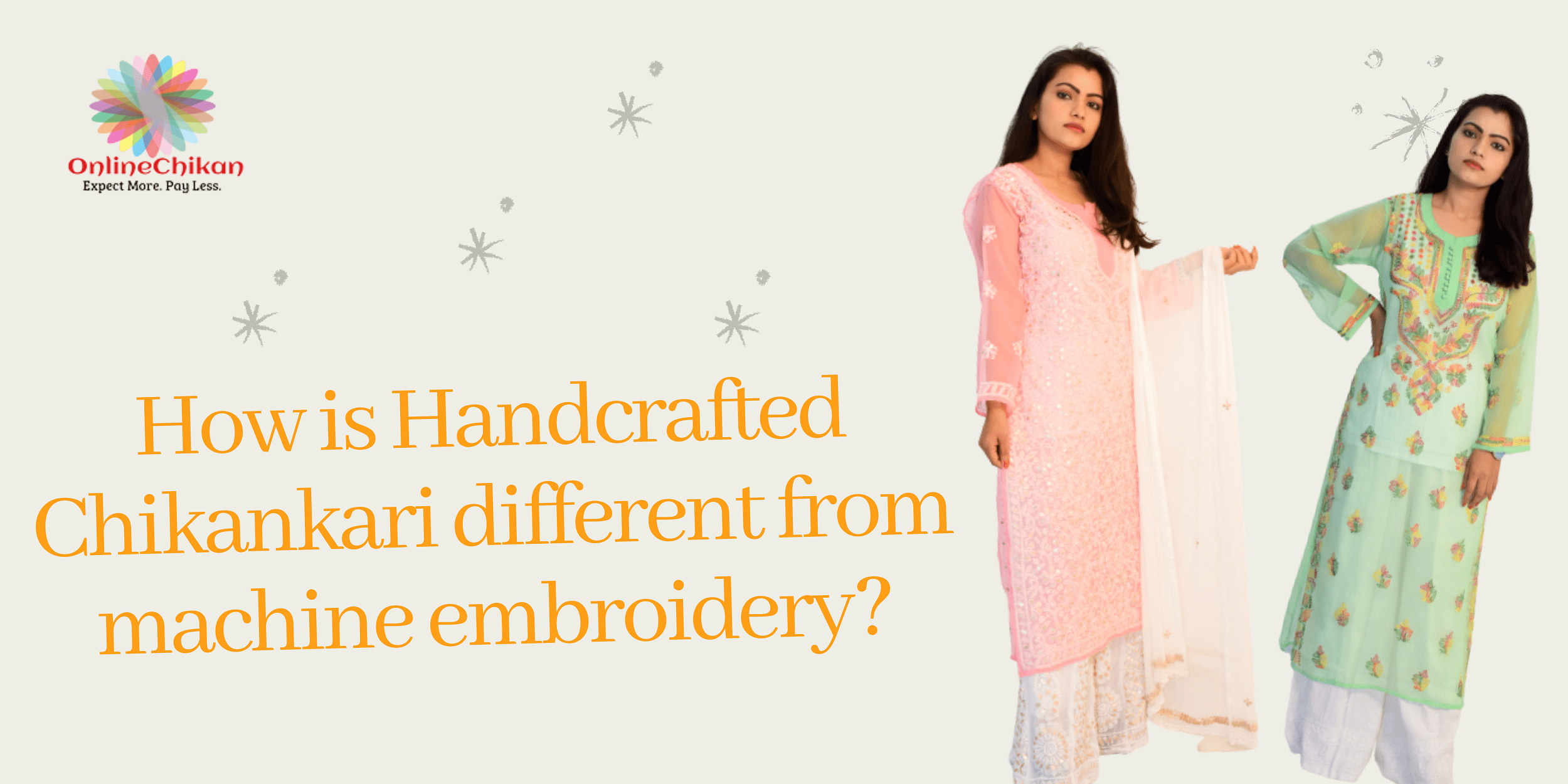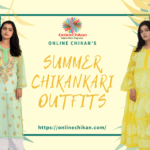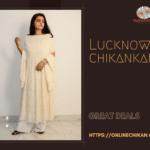Chikankari is a famous handicraft from the land of Nawabs Lucknow (U.P). As the name suggests Handcrafted chikankari means chicken ki karahi in Hindi but it comes originally from Persia (Iran) which means creating delicate patterns on a Fabric. It offers exquisite Nawabi cuisine.
However, it is believed that chinkara has been popularized in India by the wife of Mughal emperor Jahangir. It is also known as shadow work. The reason for calling it shadow work is because the embroidery is done on the wrong side, and we see its shadow on the right side.
Let’s take you further in the article for more detailed knowledge about Lucknowi chikankari and machine embroidery.
All you need to know about handcrafted chikankari
The chikankari embroidery is traditionally done on mulmul-a fine muslin cotton fabric made up of a plain weave technique. It means that a single weft thread alternates over and under a single wrap thread. Chiknkari’s name comes from the city of Mosul, Kurdistan(Modern Iraq) where it was first manufactured in the 17th and 18th centuries.
Nowadays Lucknowi chikankari work with needles and raw thread on a variety of fabrics like cotton, muslin, silk, organza, chiffon, net, etc. Earlier the fabric was embroidered using white thread but, in due course of time, colored threads started being used to see a trend and keep it updated with modern taste. It is also embellished and adorned with sequin, beads, and mirror work to enrich its appearance.
Chikanakri is an ancient form of white floral embroidery but, now, many-colored cotton threads are used to create the design patterns over the cloth. Golden zari, silver zari, wool are the types of threads also used to do chikankari embroidery. Also, the Fabric is used for making Kurti and sarees.
Initially, the design to be stitched is block printed. Block printing is the process of printing patterns by the means of engraved wooden blocks. Block printing by hand is a slow process but capable of yielding highly artistic results. The printed fabric is ready to start embroidering. The cloth is fixed to the frame, and the frame helps in avoiding contact with the already worked part. To start the stitching, the pattern is decided. Pattern here refers to a style called Motif, made up of lines, shapes, and repeating shapes.
A hole is pricked in the fabric, and the threads are torn apart. It is then held by small straight stitches all around and worked with one thread. It can be worked with 6 threads. Chickankari has flourished owing to the variety of stitches and designs. There are 10 principle stitches made from raw skeins. There are about 26 more that make about 36 different stitches that adorned the fabrics of Lucknowi chikankari.
Types of stitches Handcrafted chikankari:-
- Herringbone stitch
- Double back stitch
- Running stitch
- Stem stitch
- Satin stitch
- Pulled thread work
- Romanian stitch
A chikankar becomes proficient in chikankari by training for about 10 years to learn the complex art, and after training, it takes about 15 days to finish work on a set.
Let’s talk about machine embroidery
Machine embroidery is an embroidery process in which a sewing machine or embroidery machine is used to create designs on the fabric. In 1980 the first computerized embroidery machine was introduced.
These machines darn feet instead of the walking foot. The free motion foot is perfect for quilting because it lifts and lowers in the same way as a walking foot does so there is less movement of the fabric layer.
There are many types of machine embroidery:-
- Free motion machine
Create designs using a basic zigzag sewing machine. It is used primarily for tailoring. It lacks automated features.
- Cornely hand-guided
The operator orients the machine according to the model. The movement of the fabric is affected through a crank placed under the machine. It has a universal drive system controlled by a handle.
- Computerized machine
Modern embroidery machines are operated by specially designed computer-controlled systems.
We found the uniform design on each garment without any error, in less time and at a cheaper price. We can produce more products with accuracy. The limitation of hand embroidery restricts the artist to some specific types of designs.
Which one is the best
Handmade embroidery and machine-made embroidery both have some pros and cons. A hand-embroidered is more artistic and personal. The process requires an investment of time and dedication. It is Depend on the skill of the person with the needle, hand embroidery can result in a piece of art that will make a unique display to be enjoyed by all.
Machine embroidery on the other hand produces more professional-looking work in a fraction of the time it takes to do something similar by hand. If you prefer hand embroidery the person must have a good experience while if you prefer machine embroidery no previous embroidery experience is required instead of it you must know how to operate the machine properly.
It is the sewing process that marks a line of difference between hand embroidery and machine embroidery. Hand embroidery allows for a variety of stitches, thread, and fabrics but, machine embroidery is very uniform, and all the pieces are identical.
Machine embroidery is computer-generated pre-made patterns that are inputted into a computer program. In hand embroidery, we can add a personal choice to make it special while machine embroidery looks identical. In hand embroidery skills artists need more time and money in comparison to machine embroidery.
Handmade embroidery uses few colors but, machine-made works with many colors at a time. Handmade embroidery leaves many knots behind the side but, machine-made leaves few threads hanging on the reverse side to make a smooth finish.
Conclusion
If you are choosey and want a classical ethnic embroidery with a personal touch you should prefer hand embroidery. Even though it takes more time and more money. If you want something special as per your choice without care for money then you should go for handmade embroidery. You can get Chikan Suit Latest Design, Chikankari Saree, georgette chikankari kurti, chikankari lehenga, aari design from OnlineChikan.com
At the same time, If you want unlimited designs within a short period and an affordable price you should go with machine embroidery. So, for colorful, identical, smoother, less expensive, and more available, we should opt for machine-made embroidery



